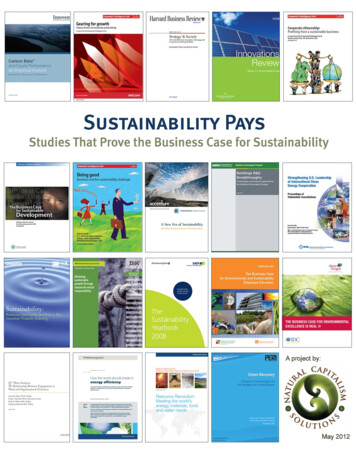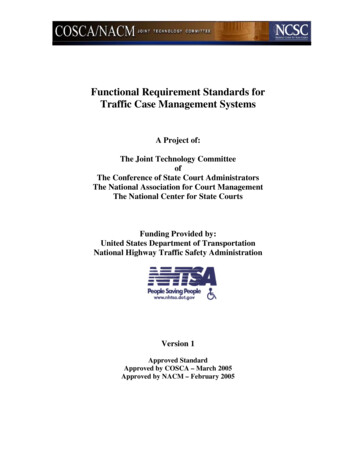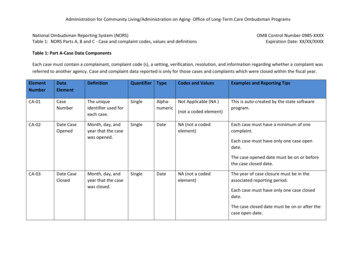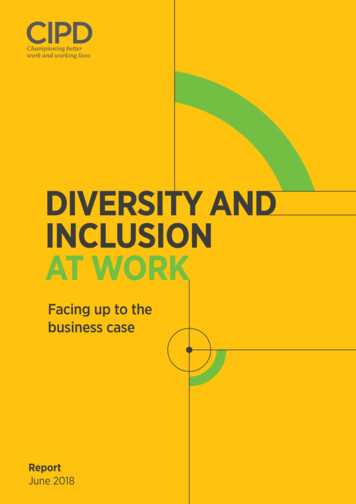
Transcription
Sustainability PaysStudies That Prove the Business Case for SustainabilityWhen those wild-eyed environmentalists at Goldman Sachs tell you that thecompanies that are the leaders in sustainable, social and good governancepolicies have 25% higher stock value than their less sustainable competitors,there’s a business case for behaving in ways that are more responsible to theplanet and to people.This annotated list describes the ever-growing number of studies, most byconventional management consulting houses, academic institutions and similarestablishment entities that prove this assertion.As climate change, natural resource constraints, rapid development in emergingeconomies, and a host of other factors drive unprecedented changes inbusiness, this will only grow stronger.This document is a resource to help you understand how business leaders canprofit by integrating sustainability into their strategy and value-chain whilesecuring a competitive advantage.Leading companies increasingly will evaluate their performance using anintegrated bottom line. This new measure places financial performance in thecontext of a firm’s environmental and social impacts to gauge its competitivenessin the marketplace more holistically. It recognizes the interdependent relationbetween business, environment, and society and emphasizes that businessesgain by identifying shared opportunities to support all three.
Businesses can improve short- and long-term profitability through the adoption ofsustainable practices in the following areas:Natural Resource, Energy, and Operational EfficiencyReduce input and overhead costs, militate regulatory sanctions, hedge exposureto volatile prices and supply chain disruptions, and mitigate environmentaldegradation, and conserve capital for implementing a long-term growth strategy.See studies. Goldman Sachs, Deloitte, Interface Inc., McKinsey, Pricewaterhousecooper, Center for American ProgressHuman Resources ManagementRetain experienced workers, prevent the loss of corporate knowledge, lowertraining costs, reduce employee absenteeism, improve worker productivity, andrecruit the best talent. Goldman Sachs, Gallup, Economist Intelligence Unit, IBM, NEEFFinancial OperationsIncrease market capitalization and stock growth, improve investor relations, lowerinsurance premiums, decrease borrowing costs, and Improve access to capital.Goldman Sachs, Economist Intelligence Unit, Ethisphere, Gallup, IBM, Innovest, Johannes Kepler University, SAM, University of CaliforniaMarketing and CommunicationExpand customer base, differentiate products, improve brand image, and securecustomers that are less sensitive to price, have greater brand loyalty, purchasemore and more frequently. Goldman Sachs, Accenture, DeloitteCollaboration with NGOs and GovernmentGain access to new markets, better supply-chain management, strengthenregulator and community relations, improve brand image, mitigate risks to brandreputation, militate government sanction. Goldman Sachs, Accenture, Economist Intelligence Unit, IBMThe field was created by the seminal work NaturalCapitalism: Creating the Next Industrial Revolution, Hawken,Paul, Lovins, Amory, Lovins Hunter, Little Brown 1999.It’s sequel, The Way Out: Kickstarting Capitalism to SaveOur Economic Ass, Lovins Hunter, Cohen Boyd, FarrarStraus, Giroux, brings the argument up to date, 2012.
Goldman Sachs (2007)“GS Sustain”Goldman Sachs Sustain investing framework incorporates 25 quantifiable,environmental, social, and corporate governance (ESG) indicators to identifyinvestment opportunities. The firms on the list outperformed the MSCI worldindex between 2005 and 2007 by 25% with a success rate of 72%. Key findingsof this report: There is “dramatic increase in the number of investors seeking to incorporate”ESG factors into their investment portfolios” ESG indicators are “a good overall proxy for the management quality ofcompanies relative to their peers” To attract and retain Generation-X employees companies “need to providerewards beyond financial gain”, by aligning corporate values with employeevalues” Increasing numbers of consumers identify themselves as “being sociallyresponsible” and firm’s ESG is a major factor influencing brand loyalty (35%) There is unprecedented transparency in the operating environment of firms,and consequently firm’s ESG programs are receiving increased scrutinyAccenture (2010)“A New Era of Sustainability: UN Global Compact-Accenture CEO Study”This is an extensive study on CEO’s perspectives of sustainability issues, totaling766 respondents from 26 countries and a wide array of industries. It was thelargest and most extensive survey ever conducted on the topic of sustainability.The study examined how CEOs’ strategies are evolving, and the conditionsnecessary to shift the market, toward greater social and environmentalresponsibility. Key findings include: Over 93% of CEOs see sustainability as crucial business success, with 88%stating such issues are fully embedded into their strategy and operations 72% of CEOS believe strengthening brand reputation and trust amongconsumers and governments is the “strongest motivator for taking action onsustainability” Greatest barrier in implementing sustainability occurs in a company’s supplychain and subsidiaries. While 91% and 88% (respectively) agreed thatsustainability should be incorporated into each, only 59% and 54%acknowledged it had been. Many CEOs believe the investment community is not supporting corporateefforts to create value through sustainable products and services by failing tofactor sustainability performance into valuation models. However, otherssuch as Goldman Sachs disagree (see GS Sustain).
Accenture (2011)“The Chief Executive Officer’s Perspective”As sustainability concerns increasingly arrive at the desks of CEOs, manybusiness leaders are debating how to manage and lead their organizationsstrategy and initiatives. Some CEOs have decided to grant sustainability aposition in the C-Suite with the creation of a new position: chief sustainabilityofficer. Others, however, have pursued a decentralized approach and haveallocated various sustainability responsibilities throughout departments andlevels of management. This report examines how CEOs are managingsustainability, and how to ensure successful integration of sustainabilitythroughout an organization.AT Kearney and Institute for Supply Management (ISM) Survey of 25 NorthAmerican Fortune 500 Companies“”True” and Profitable Sustainability Management. How Supply Management isKey to Fulfilling a Profit”This report highlights how 25 leading companies are engaging on sustainabilityand how, “management can use sustainability to improve profitability”. Thesurvey revealed that a majority of companies recognize that addressingsustainability is a core business concern and needs to be integrated directly intobusiness strategy. Yet, many lack the formal direction and processes necessaryto implement sustainability such as tracking sustainability metrics, or a methodfor identifying supply-chain risks.Atos Origin (2009)“The Business Case for Environmental Excellence is Real”This report is based on an extensive study of senior managers and executives at165 European companies and trade association. It concludes that, “the businesscase for environmental excellence is real” and environmental sustainability“deliver[s] additional profits and competitive advantage” for companies. Theauthors effectively argue the business case for sustainability, outline a methodfor creating a profitable environmental program, and discuss the benefits andelements of such. In particular, this report provides detailed insight intosustainable business opportunities for the automotive, technology, chemical,consumer goods, and retail industries to mitigate supply-chain and regulatoryrisks while improving profitability.
Deloitte (2007)“Sustainability: Balancing Opportunity and Risk in the Consumer ProductIndustry”“Proactive sustainability initiatives are an opportunity for companies todifferentiate themselves as leaders in the industry, the environment, and society”,secure “competitive, and operational advantages”, and “ensure long-termbusiness success.” This report closely examines the drivers and implications ofsustainability in the retail and consumer products industries; discussions ofmarket leaders’ sustainability initiatives; an evaluation of current businessmodels’ ability to adapt; and how to structure and execute a successfulsustainability program. It also provides a discussion of the environmental,consumer, brand, governance, and compliance implications of sustainability.Lastly, it details how sustainability should be integrated into business strategy,operational process, an internal governance and employee engagementinfrastructure, and supported by collaboration with NGOs, activist organizations,and governmental agencies.Deloitte (2009)“Sustainability Trends and New Shopper Insights”This survey of over 6,000 retail customers focuses on the consumer productindustry and how retailers can profit from integrating sustainability through theirvalue-chain, with a specific focus on retail operations. It discusses how thesustainable consumer segment is evolving, and how firms wishing to capitalizeon this “high-value” segment should form a strategy. Key highlights include: Green consumers shop more frequently, purchase more per trip, and areless price sensitive than the average shopper Green shoppers tend to become loyal to green products once they have triedthem Sustainability considerations drive or influence the buying decisions of morethan half the shoppers interviewedDeloitte (2011)“Sustainable Finance: The risks and opportunities that (some) CFOs areoverlooking
Economist Intelligence Unit (2008)“Doing Good: Business and the Sustainability Challenge”This extensive survey of business leaders covers a wide range of topicspertaining to how businesses perceive, adapt, and implement strategies inresponse to sustainability concerns. Issues covered include: Business leader motivations for pursuing sustainability initiatives Implementing sustainability throughout a business How globalization is increasing stakeholder demands of business becausecompanies in under-developed regions are often the only institution capableof solving pressing social and environmental problems Perspectives of sustainability and the role that government, institutions, andconsumers play in supporting sustainable objectives Evolving relations between business and NGOs from confrontation tocooperationEconomist Intelligence Unit (2008)“Corporate Citizenship: Profiting from a Sustainable Business”“If corporate citizenship were a frill and had no clear benefit it ought not survive in anyeconomic climate, good or bad. But, if it is viewed as something tied to business strategywith a real, measurable and clear return on investment established over time, then it’snot viewed as something you can or should do less of in a time of economic crises.”Stan Litow, VP for corporate citizenship and corporate affairs at IBMIn September of 2008 the Economist Intelligence Unit conducted a survey of 566US-based executives. The final report discusses the necessary foundations forcreating profitable corporate citizenship (CC) initiatives and strategies. Some keyfindings include: Respondents who claimed CC is “very important” to their firm’s overallbusiness strategy reported their profitability and revenue growth is “stronger”(57%) or “much stronger”(52%) than their closest competitor’s, compared to41% and 38%, respectively, for those who do not see their strategy in thisregard. Corporate citizenship must be driven from the top, but leadership from alllevels is crucial because strategy is only as good as its execution. Successful companies find ways to channel the passion of their employeesinto corporate citizenship activities, which helps employee recruitment andlowers employee turnover. Financial returns are critical for convincing senior executives that CC isimportant. This requires solid measurements and metrics for trackingprogress, and linking these to financials. Non-traditional partnerships with local, state and federal government, andNGOs are important for securing significant financial advantages.
Economist Intelligence Unit (2011)“Gearing for Growth: Future Drivers of Corporate Productivity”This survey collected responses from 379 senior level managers in “all majorindustries” regarding their firm’s approach to improving corporate productivity.Highlights include: 85% of companies believed that managing human capital was the mostimportant method for improving productivity "Many leading companies” claimed that “engaging employees onsustainability” is a “powerful motivating tool”, and “improved customersatisfaction, increased productivity, and reduced employee turnover andabsenteeism” Focusing too much on cutting costs rather than maximize existing resourcesand labor was cited as the most common strategic problemEnvironmental Defense Fund (2008)“Innovations Review: Making green the new business as usual”Environmental Leader (2011)“Does Corporate Social Responsibility Increase Profits?”Ethisphere (2011)“2011 World's Most Ethical Companies”This list of the world’s most ethical companies has been published annually since2007. Since it began, companies that have comprised the list have consistentlyoutperformed numerous equity indexes. On average, listed companies“outperformed the S&P 500 by delivering a nearly 27 percent return toshareholders since 2007, compared to the S&P's negative 8.5 percentshareholder return during the same period." The rating methodology includessuch numerous quantifiable corporate citizenship measures, in categoriesranging from reputation and litigation history, to its internal culture.EU Environmental Business Awards (2006)“Twelve European companies vying for European Business Awards for theEnvironment”
Gallup (2009)“The Relationship Between Engagement at Work and Organizational Outcomes”This scientific meta-analysis evaluated numerous studies linking employeeengagement to key business units and finds that business can secure greaterprofitability by actively engaging employees. Comparing top-quartile to bottomquartile engagement business units resulted in median percentage differences of 12% in customer loyalty 16% in profitability 49% in safety incidents 18% in productivity 27% in shrinkage 25% in turnover for high-turnover 37% in absenteeismcompanies (those with 60% or 41% in patient safety incidentshigher annualized turnover) 60% in quality (defects) 49% in turnover for low-turnovercompanies (those with 40% orlower annualized turnover)Gallup (2011)“Majority of American Workers Not Engaged in Their Jobs”Harvard Business Review (2006)“Strategy and Society: The Link Between Competitive Advantage and SocialResponsibility”Harvard Business Review (2010)“The Sustainability Imperative”Executives are increasingly recognizing sustainability as the next megatrend (an“incipient societal economic shifts”, like globalization or the informationtechnology revolution). Yet, as business leaders launch a, “hodgepodge ofinitiatives” to address sustainability they often fail to recognize the holistic, multistage strategy necessary to succeed in today’s rapidly evolving marketplace. Byresearching numerous, past megatrends, the authors have identified four stagesthat firms who became market leaders progressed through: Stage 1: Reduce waste, risks, and costs Stage 2: Redesign products, processes, and functions to optimizeperformance Stage 3: Integration of sustainability with corporate strategy Stage 4: Differentiation and creating a new business modelUsing this insight, the authors discuss in detail how; leadership, reporting andcommunication, methods for assessing value, strategy development andmanagement integration are critical for creating a sustainability performancemanagement system and how today’s executives can help their firms Capturethe Eco-premium.
IBM Global Business Services (2008)“Attaining sustainable growth through corporate social responsibility”This report is based upon a survey of 250 business leaders worldwide andnumerous interviews. It discusses the increasing importance CSR has onbusiness strategy and covers three business dynamics that businesses need tounderstand when approaching CSR: its impact on business profitability andgrowth; the benefits of transparency; and the advantages provided by interorganizational collaboration. Key findings include that companies that report theyare substantially outperforming their competitors are more than twice as likely to: Be transparent about the sourcing, composition, and impacts of theirproducts, services, and operations Engage all employees in CSR initiatives Place critical importance on aligning philanthropy and business priorities Consider themselves very effective at developing products and services witha positive societal or environmental impactInnovest (2007)“Carbon Beta and Equity Performance: Moving from Disclosure to Performance”This report details an investment framework designed to hedge against climatechange risks, specifically those associated with carbon emissions that affectinvestments’ financial performance. It provides an explanation of the how, andwhat, certain companies’ exposure to carbon emission in carbon-restrainedeconomy may be and how they would affect financial feasibility. It addressesrisks that firms face both directly and in-directly, and specifically discusses theregional differences that exist across the globe. It concludes by providing variousstatistical analyses that demonstrate market leaders in reducing carbon risk haveoutperformed their peers in regards to stock growth and market capitalization.Interface Inc.“A Better Way, Try it. The business Case for Sustainability” Speech given by RayAnderson, Chair of Interface – see also Interface website:Ray Anderson, founder of Interface, is the author of this article covering howintegrating sustainability throughout an organization provides a host ofunanticipated, and profitable, benefits. This case study highlights Interface’ssuccess with how eco-oriented products not only lower costs and expand thecustomer base but also provides a platform for innovation. In pursuit ofimplementing a closed-loop manufacturing system, Interface significantlyreduced waste, and energy and natural resource consumption at a profit.
Johannes Kepler University and Vienna University of Economics andBusiness Administration (2008)“Does CSR Increase Firms’ Profits? Evidence from DJSI Firms”McKinsey (2011)“The Business of Sustainability”This survey, the sixth conducted by McKinsey, discusses how executive“understand and manage issues related to sustainability”. This year’s resultsreveal that addressing sustainability is current rapidly evolving business trend.“More executives are reporting that sustainability initiatives are addingshareholder value” in both the short- and long-term. The report provides adiscussion of how senior manager’s approaches to sustainability are changing,where their focus is, the barriers they are encountering, and the most achievableopportunities to add sustainable value.McKinsey (2011)“Resource Revolution: Meeting the world’s energy, materials, food, and waterneeds.”MIT Sloan Management Review & Boston Consulting Group (2010)“The Business of Sustainability”Natural Capitalism Solutions“The Economic Case for Climate Protection”This paper sets forth the evidence that there is a suite of policy measures to helpthe market solve the climate crisis not at a cost but as an investment in a farbetter future for all of the world’s people. It describes how this future is alreadyemerging remarkably rapidly despite Federal policy that restricts it at every turn.Finally it sets forth the economic policies that can unleash the new energyeconomy and set the country on the course to prosperity, security andstewardship.
National Environmental Education Fund (2010)“The Business Case for Environmental and Sustainability Employee Education”This study, conducted in conjunction with GreenBiz, provides a number of casestudies on employee engagement (EE) through environmental and sustainabilityeducation (E&S). Key findings include: “Losing and replacing a good employee costs companies between 70%–200% of an employee’s annual salary” and that “employee engagement hasresulted in increased employee loyalty, more company pride, and improvedmorale.” “Front-line employees are often in the best position to identify inefficienciesand propose improvements. E&S education of employees can improveprofitability by supporting greater efficiency through less waste, water andenergy usage” Companies that equip employees in sales, marketing and other customeroriented positions with knowledge of the environmental attributes ofofferings, and environmental issues to place those attributes in context, willstrengthen relationships with customers who have similar values or interests.Pricewaterhousecooper (2011)“Minerals and Metal Scarcity: the ticking time bomb”This thorough analysis of global mineral and metal scarcity demonstrates thatsignificant drivers of sustainability principles relate to geo-economic and –politicalconcerns. Key quotes include: “The risk of scarcity is expected to rise significantly, leading to supplyinstability and potential disruptions in the next five years, but this alsocreates opportunities for competitive advantage” “Economic and political drivers of scarcity are generally seen as muchmore important than physical drivers” “Efficiency is seen as most plausible response to scarcity”Sustainable Asset Management (2008)“SAM. Creating Sustainable Value”
Sustainable Asset Management (2008)“The Sustainability Yearbook”This annual publication, conducted in conjunction with PriceWaterhouseCooper,discusses sustainability trends within a wide array of corporate sectors. It coversconsumer products companies’ greater engagement with sustainable productdesign, and addressing the full life-cycle impacts of their products or services. Itreviews an empirical analysis and implications of how sustainability performanceeffects financial valuations. It discusses the failure of water markets, and theinvestment opportunities that exist for firms in efficiency technologies. The reportprovides an “at a glance” review of the implications of sustainability for a widearray of industries. A few quotes include: “There is a positive, statistically significant, linear association betweensustainability and corporate financial performance” “More and more companies consider the consequences of finite naturalresources, climate change effects, impacts of emissions to air, water andsoil and implications of unethical business behavior in their businessmodels and embed their actions into consumer propositions to gaincompetitive advantage”Sustainable Asset Management (2012)“The Sustainability Yearbook”University of California, Berkeley & University of California, Davis (2012)“Going Green: Market Reaction to CSR Newswire Releases”This study examines how shareholder valuations change following firms’voluntary disclosure of greenhouse gas emissions and management strategies.Key findings include: On average, disclosing carbon emissions, reduction targets, and relevantmanagement strategies, increases firms’ market capitalization Voluntary carbon disclosure produces positive returns to shareholders Small companies tend to receive relatively greater returns than largercompanies.Maine Sustainable Businesses and Programs (2005)
McKinsey (2007)“A cost curve for greenhouse gas reduction”This study provides valuable insights for business on the most cost-effectivemeasures to reduce greenhouse gas emissions (GHG), and the potentialstrategies that policy-makers may adopt pertaining to GHG regulations. Findsinclude: Approximately 25% of initiatives discussed offer the potential GHGreductions with a zero or negative net life cycle cost, mainly in transportationand building efficiency. Power generation and manufacturing industries accounted for less than halfof the low-cost potential for reducing GHG emissions, indicating regulationsmay target the transportation, buildings, forestry, and agriculture sectors nergyintensiveindustry’s production economics, cost competitiveness, investment decisionsand the value of various assets.McKinsey (2008)“How the world should invest in energy efficiency”“The economic case for energy productivity investments has never beenstronger.” This report recommends that 170 billion be invested globally ( 57billion in the US) in energy efficiency (EE) by 2020. It states that this investmentwould halve global growth in energy demand and curb GHG concentrations at450ppm, while achieving attractive financial returns. The recommendedinvestments average a 17% internal rate of return (IRR), and at minimum providea 10% IRR. The report provides a general discussion of where EE investmentsshould be made in industrial, residential, commercial, and transportation sectors;how financing may be secured; and the current barriers to investment.Center for American Progress and the Political Economy ResearchInstitute (2008)“Green Recovery: A Program to Create Good Jobs and Start Building a LowCarbon Economy”Innovest and the World Wildlife Fund-UK (2007)UK Power Giants Generating Climate Change
U.S. Department of Energy: Building Technologies Program (2011)“Buildings R&D Breakthroughs: Technologies and Products Supported by theBuilding Technologies Program”Buildings accounted for 40% of U.S. primary energy consumption in 2008. Thisreport identifies and characterizes numerous energy efficiency technologies thatare categorized into three groups: commercially available products,emerging technologies, and potential technologies. Specifically, the reportfocuses on four types of technologies: envelope materials, HVAC and watersystems, lighting, and windows. It also found that private companies are drivinginvestment in energy efficiency technologies for buildings, and are responsiblefor 75% of all commercially available and emerging technologies.National Renewable Energy Laboratory (2008)“Strengthening U.S. Leadership of International Clean Energy Cooperation”World Business Council for Sustainable Development (2002)“The Business Case for Sustainable Development. Making a difference towardthe Johannesburg Summit 2002 and beyond”Florida’s Energy and Climate Change Action Plan (2007)“A Report to Governor Charlie Crist, Phase 1”Conducted by: Governor’s Action Team on Energy and Climate ChangeFlorida’s Energy and Climate Change Action Plan (2008)“A Report to Governor Charlie Crist, Phase 2”Conducted by: 2008 Center for Climate Strategies
Stan Litow, VP for corporate citizenship and corporate affairs at IBM In September of 2008 the Economist Intelligence Unit conducted a survey of 566 US-based executives. The final report discusses the necessary foundations for creating profitable corporate citizenship (CC) initiatives and strategies. Some key findings include:











